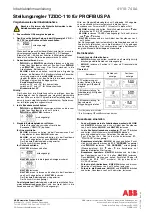
TZIDC-200, TZIDC-210, TZIDC-220
DIGITAL POSITIONER | 42/18-85-EN REV. E
17
ATEX – ‘Ex i’ type of protection
Ex marking
Marking
II 2 G Ex ia IIC T6 or T4 Gb
II 2 G Ex ib IIC T6 or T4 Gb
II 3 G Ex ic IIC T6 or T4 Gc
Type Examination Test Certificate
TÜV 02 ATEX 1834 X
Type TZIDC-220
Standards EN
60079-0
EN 60079-11
EN 60079-27
Temperature Data
Device group II 2 G
Temperature class
Ambient temperature Ta
T4
−
40 to 85 °C
T6
*
−
40 to 40 °C*
* When using the ‘Limit Monitor’ plug-in module in temperature class T6, the
maximum permissible ambient temperature range is
−
40 to 35 °C
(
−
40 to 95°F).
Electrical Data
With the intrinsic safety Ex i IIC type of protection, only for
connection to a certified FISCO power supply unit or a barrier,
i.e., a power supply unit with maximum values in accordance
with the following table.
Current circuit (terminal)
Electrical information (maximum values)
Signal circuit
(+11 /
−
12)
U
i
= 24 V
I
i
= 250 mA
P
i
= 1.2 W
C
i
= < 5 nF
L
i
= < 10 µH
Characteristic curve =
linear
Current circuit (terminal)
Electrical information (maximum values)
Mechanical digital feedback *
(Limit1: +51 /
−
52),
(Limit2: +41 /
−
42)
For maximum values, see EC type examination
certificate
PTB 00 ATEX 2049 X
* When using the SJ2_S1N (NO) proximity switch, the positioner may only be
used at an ambient temperature range from
−
25 to 85 °C (
−
13 to 185°F)
Special conditions
• Before final installation, the operator needs to decide on the
use of the device, either
A) as a device with ‘Ex i’ intrinsically safe type of protection
or
B) as a device with ‘Ex d’ type of protection
and permanently mark the selected type of use on the name
plate. Specific conditions of the surrounding environment,
such as chemical corrosion, must be taken into account when
affixing the permanent mark. Only the manufacturer must
change the selected type of use following a re-examination
• Variants that, according to declarations, also meet the
requirements for the ‘flameproof enclosure’ type of
protection may no longer be used as ‘intrinsically safe’ if they
have been previously used as a flameproof type of protection













































